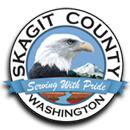Planning and Development Services
SKAGIT
COUNTY COMMISSIONERS ANNOUNCE PLAN TO CREATE SKAGIT COUNTY SALMON HERITAGE PROGRAM
SKAGIT COUNTY - The Skagit County Board of Commissioners will announce plans to create the Skagit County Salmon Heritage Program at a press conference, Thursday, March 22, 2007 at 3:00 p.m. at 1800 Continental Place, Mount Vernon, Washington. Modeled on Skagit County's highly successful Farmland Legacy Program, the Salmon Heritage Program will acquire conservation easements along key salmon streams in agricultural areas.
"Salmon and agriculture represent a shared heritage here in Skagit County, and we have a moral obligation to safeguard both for future generations," said Skagit County Commissioner Sharon Dillon. "We're determined to protect agriculture and salmon in Skagit County. The Salmon Heritage Program demonstrates our commitment to the task."
The Salmon Heritage Program will pay fair market value for riparian habitat easements. It is anticipated initial funding for the program will come from a county-wide voter-approved ballot measure, to be scheduled for August 2007.
Skagit County is actively seeking participation from state, federal, tribal and private sources. "We're stepping up and demonstrating resolute leadership on salmon recovery and water quality," said Dillon. "But we need financial help. We hope our state and federal governments are listening, because healthy salmon runs and clean water in the Skagit River benefit our entire region. We also hope our Tribal neighbors will continue to partner with us in this important effort."
The Skagit River is the only Puget Sound river system with all five Pacific salmon species. Importantly, the Skagit River has the largest remaining wild runs of threatened Puget Sound Chinook salmon, which are the key prey species for endangered Puget Sound Orcas. The Skagit River watershed is the source of more than one third of the fresh water entering Puget Sound. Riparian habitat is important for salmon, but a high proportion of Skagit and Samish River salmon spawning streams are in rural areas. Rural landowners generally receive no compensation when riparian buffers are imposed by governmental regulations. In many cases, farmers can lose eligibility for federal farm program assistance if riparian buffers are imposed by regulation.
During last fall's election, Skagit County farmers were divided on the issue of Initiative 933, a hotly-contested statewide ballot measure that would have required local governments to pay fair market value whenever land use regulations restrict property rights. I-933 was defeated at the polls, but the Skagit County Commissioners were listening to agriculture's concerns.
"I-933 went too far, and was wrong for Skagit County. But the farmers who supported I-933 had a valid point, and we're directly responding to their concerns," said Skagit County Commissioner Ken Dahlstedt. "The Salmon Heritage Program will help meet the County's obligation to protect salmon and water quality, but at the same time will ensure farmers aren't bearing the burden alone. The Salmon Heritage Program actually does more for agriculture than I-933 would have done. It's the right thing to do for farmers, for salmon, and for the future of our county."
By voluntarily selling an easement to the Salmon Heritage Program, Skagit County contends that landowners will meet all critical areas requirements arising from state and federal environmental laws under Washington's Growth Management Act, as well as other County requirements arising under state and federal environmental laws. Skagit County will stand with landowners who benefit the community by selling an easement. "The Salmon Heritage Program is intended to protect farmers in perpetuity, and it will form a key component of Skagit County's proactive salmon recovery strategy," said Skagit County Commissioner Don Munks. "The Salmon Heritage Program is intended to help address our obligations under the Growth Management Act, as well as Clean Water Act, Endangered Species Act, and Ecology TMDL requirements."
To the extent a Department of Fish and Wildlife habitat conservation plan is in place, owners of on-going agricultural land in dike, drainage and sub-control districts will not be asked to sell riparian habitat easements. Easement acquisition under the Salmon Heritage Program will focus on rural lands with salmon spawning streams. However, the Salmon Heritage Program is crafted to provide long-term protection and certainty for Skagit County's agricultural community.
Over the past ten years, Skagit County has spent millions of dollars on litigation over how to protect both agriculture and salmon.
"We're excited about getting off the litigation track, and moving decisively forward on salmon recovery in partnership with landowners, state and federal agencies, local tribes, salmon recovery groups and other stakeholders," said Dillon.
The first phase of the Salmon Heritage Program is focused on easement acquisition, and will seek partnerships with organizations willing to perform riparian restoration on the easements acquired. After successful completion of Phase I, the Program will focus on salmon habitat restoration and recovery activities.
'With the listing on the Puget Sound Orca and Chinook Salmon, Bull Trout and anticipated listing of Steelhead under the Endangered Species Act, we have to assume as leaders that environmental regulations will only get tougher in the coming years. That's why we must take charge of our own destiny, at the local level and craft a proactive solution that works best for Skagit County. The Salmon Heritage Program is a big step in that direction," Dillon said.
Skagit County is in the process of implementing the Salmon Heritage Program, and will release proposed ordinances and resolutions for public review and comment in the near future.
Additional information is posted online at www.skagitcounty.net
For further information,
contact: Will Honea
Skagit County Chief Civil Prosecutor
360-416-1400



















